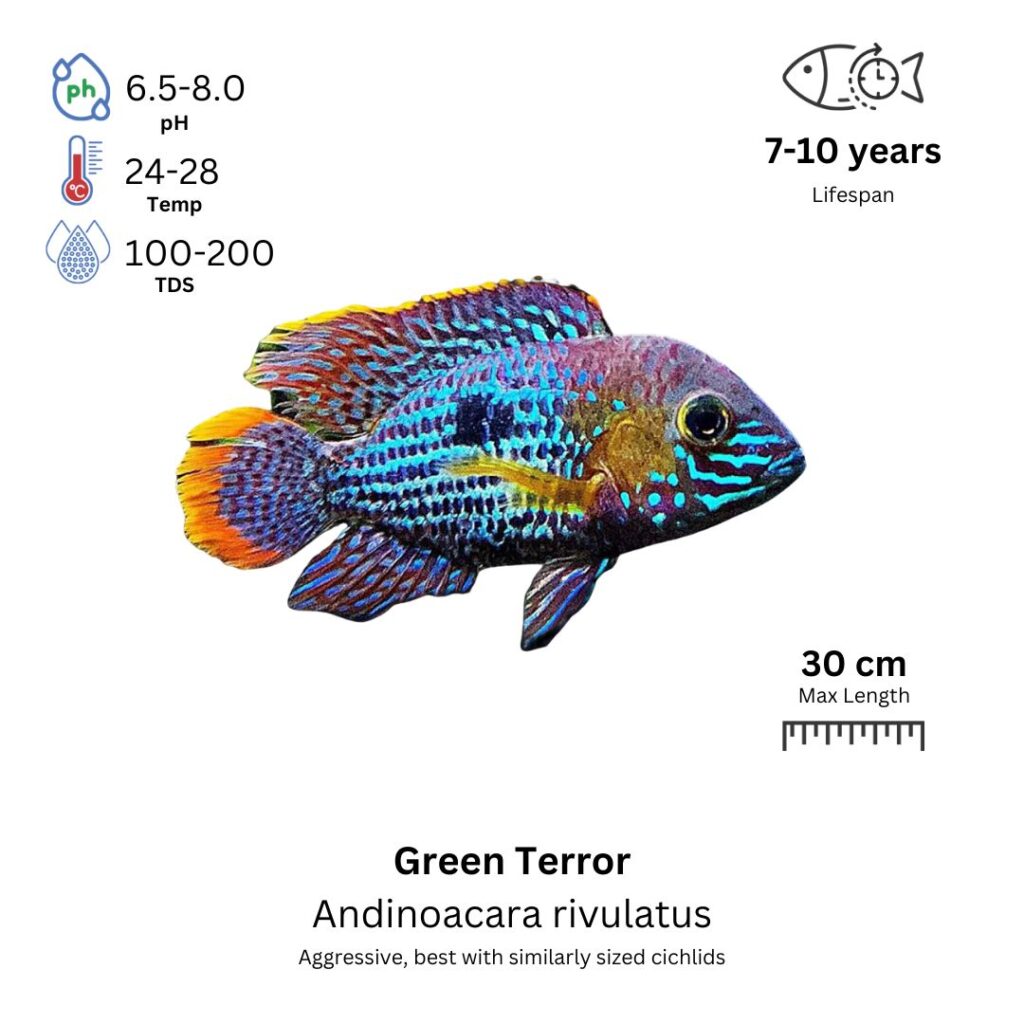Green Terror
Aequidens rivulatus

Description
The Green Terror is a striking and aggressive species of cichlid, known for its beautiful coloration and territorial nature. The body of the Green Terror is elongated, with a robust and muscular build. Its colors are vibrant, with a base of bright turquoise or greenish-blue, often with yellow and orange accents. These fish may have dark vertical stripes along their bodies, and their head and dorsal fin are often highlighted with rich metallic hues, especially in males. The males typically display brighter colors and larger fins, including a pronounced dorsal fin and a longer body size, compared to females.
Habitat Origin
Native to the freshwater rivers and streams of Central America, particularly in countries like Panama, Costa Rica, and Honduras. These fish are found in areas with moderate to fast-flowing waters, typically in shallow regions near rocks, submerged roots, and dense vegetation. In their natural habitat, they thrive in neutral to slightly alkaline water with good oxygenation.
Aquarium
Ideal Number in Aquarium: Best kept singly or with a carefully chosen mate. They are territorial and aggressive, especially during breeding, so it is important to provide enough space to reduce stress and fighting.
Favorite Food

Green Terrors are omnivores and will accept a variety of foods. They can be fed high-quality cichlid pellets, live or frozen foods such as brine shrimp, daphnia, bloodworms, and krill. They will also enjoy some plant matter, so supplementing their diet with spirulina, blanched zucchini, and lettuce will help keep them healthy. A varied diet is essential for maintaining their vibrant coloration and overall health.
Behavior:
Green Terrors are known for their bold and aggressive personalities. They are territorial fish and will often establish a space in the aquarium that they will defend from intruders. Males are particularly aggressive during breeding, and they may become highly protective of their mate and eggs. They are not suited for community tanks with smaller or more peaceful fish, as they will likely bully or prey on them. However, they can live with other larger, more aggressive species that can hold their own.
Special Care:
Green Terrors require a well-maintained tank with stable water conditions. Regular water changes and good filtration are essential, as these fish can produce a lot of waste. They appreciate a tank with plenty of rocks, caves, and plants to provide hiding spots and areas to defend. The substrate should be soft or sandy, as they are known to dig. Avoid keeping them with fish that are too small or timid, as they may be harassed or eaten. It’s important to ensure the tank is large enough to accommodate their territorial nature.
Compatibility with Other Fish:
Green Terrors can be kept with other large, aggressive fish that can hold their own, such as other cichlids (e.g., Jaguar Cichlids, Severum Cichlids, and larger species of plecos). They should not be housed with smaller fish, invertebrates, or species that are not capable of defending themselves. Even with larger species, it’s important to provide plenty of space to reduce aggression and territorial disputes. Tankmates should be chosen carefully based on size, temperament, and water requirements.
Breeding Tank Setup
A separate breeding tank is essential when breeding Green Terror Cichlids due to their territorial and often aggressive nature during spawning. A minimum tank size of 200 liters (50 gallons) is recommended to give the pair enough space to establish territory and to accommodate the fry as they grow. Maintain a pH between 6.5–7.5, temperature of 26–30°C, and hardness of 6–12 dGH. Use a strong filtration system like a canister filter, ensuring the flow isn’t too strong to avoid stressing the fish. Provide fine gravel or sand substrate and add flat rocks or ceramic caves for spawning. Since these cichlids may uproot plants, it’s best to keep decorations minimal and sturdy, with some shaded areas and low to moderate lighting.
Selecting Breeders & Conditioning
To prepare Green Terrors for breeding, feed them a protein-rich and varied diet, including live or frozen foods like brine shrimp, daphnia, and bloodworms, as well as quality cichlid pellets. This nutritional conditioning helps females develop eggs and stimulates the male’s courtship behavior. Conduct weekly water changes of 20–30% to maintain excellent water quality. Slightly increasing the water temperature to around 28°C before introducing the pair can help trigger spawning behavior.
Spawning Process
Spawning usually occurs once the pair has been conditioned and water conditions are optimal. The male displays intense coloration and chases the female as part of his courtship. When ready, the female lays eggs on a flat rock or other smooth surface, which the male then fertilizes. A healthy female can produce 100 to 500 eggs in one spawn. The male and female share parental duties, guarding and oxygenating the eggs. If any other fish are present, they should be removed to prevent predation or disruption during this sensitive period.
Fry Care & Development
The eggs hatch within 3 to 5 days, depending on the temperature. The fry become free-swimming around day 4 or 5, at which point they can be fed infusoria, liquid fry food, or crushed cichlid pellets. As they grow, baby brine shrimp and microworms can be introduced. To maintain water quality, perform small water changes (10–15%) every 2–3 days and use a sponge or low-flow filter. Keep the water stable at 26–30°C, and avoid strong currents that could stress the delicate fry.
Maturity, Sexing & Stress Prevention
Green Terror Cichlids are typically ready to breed at 1–2 years of age. Males are more colorful, often with bright orange or yellow accents and more pointed fins. Females are larger and rounder, particularly when carrying eggs, and tend to have more subdued coloration. To reduce stress and ensure successful breeding, avoid overcrowding, maintain consistent water parameters, and remove aggressive tankmates. A calm, well-maintained environment is key to encouraging natural breeding behavior and fry survival.
